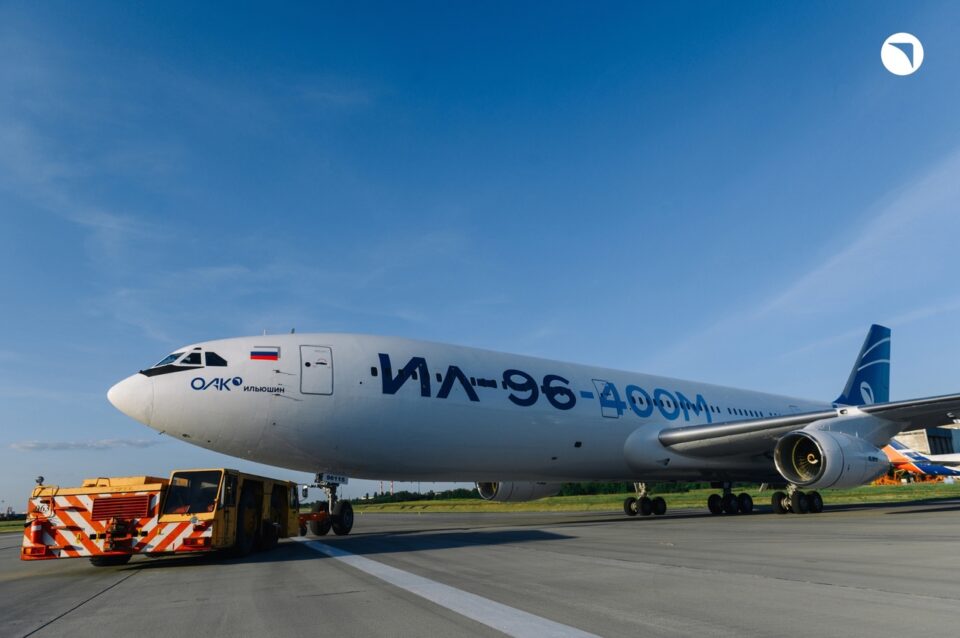Aerospace
Russia launched the IL-96 400 aircraft to take the position of widebody A350 and B777 planes.

The Russian aviation industry encountered challenges following the sanctions from Western nations. Airbus or Boeing currently operate the majority of aircraft, however with the sanction, it is now impossible for the maintenance crew to fly those models. Russian IL96 aircraft are now being used for commercial operations after first being issued for use in defense and other general aviation purposes.
Russia’s Biggest Presidential aircraft completes its maiden flight(Opens in a new browser tab)
Earlier this month, Comac exhibited its first commercial aircraft for domestic use, marking the first time the company had publicly displayed an aircraft. Now, Russia is following a similar.
Russian strategy to avoid aviation problems brought on by sanctions The IL-96 family aircraft modernization program resulted in the creation of an IL-96-400M prototype, which is currently getting ready for its first flight. The plane is painted in the new UAC group (Rostec) livery.
Since February 2017, the Il-96-400M has been in development. – It is 9.65 m longer than the Il-96-300 and can travel up to 402 passengers over a maximum route of 8,750 kilometers. – This type is expected to compete with the Airbus 350 and B777 in Russia.
About IL-96-400 aircraft
The Russian aircraft manufacturer Ilyushin created the enhanced IL-96-400 version of the IL-96 aircraft family. It is a long-range wide-body aircraft with expanded passenger capacity, improved fuel efficiency, and improved performance to meet the needs of contemporary air travel.
The IL-96-400 is outfitted with more potent and effective engines to boost its performance. It makes use of the PS-90A1 engines, an improvement on the IL-96 engines used in prior generations. These engines offer better thrust and fuel efficiency, making operations more cost-effective and environmentally friendly.
Russian IL-96 range and seats
The IL-96-400’s range of up to 10,000 kilometers (6,200 miles) makes it suited for transcontinental long-distance trips. With its expanded passenger capacity and long-range capability, it gives airlines that fly internationally an alternative that is competitive.
Over the IL-96-300, the IL-96-400 offers a number of improvements. One of the noticeable modifications is the expanded fuselage, which makes room for a larger and roomier cabin. With this alteration, the passenger capacity is increased to around 350 people with a normal seating arrangement, making it appropriate for high-volume operations.
Both local and foreign markets are showing an interest in the IL-96-400. It has mostly been used as a flagship aircraft for long-distance flights by Russian airlines. Due to competition from other well-known aircraft manufacturers, it has had difficulty breaking into the world market.

Aerospace
Boeing Transfers Rocket Stage to NASA, Paving Way for Human Moon Mission

Boeing has achieved a significant milestone by providing NASA with the second core stage of the Space Launch System (SLS) rocket.
This crucial component, crafted at NASA’s Michoud Assembly Facility (MAF), is set to propel the Artemis II crew into lunar orbit, marking humanity’s return to deep space after a 50-year hiatus.
The monumental Boeing-built rocket stage, the largest element of the Artemis II mission, will embark on a journey aboard the Pegasus barge, traveling 900 miles to NASA’s Kennedy Space Center.
Comparison of two legendary aircraft B777x vs B747 aircraft:Click here
Upon arrival, it will be meticulously integrated with other essential Artemis II components, including the upper stage, solid rocket boosters, and NASA’s Orion spacecraft within the iconic Vehicle Assembly Building. This intricate integration process is a vital step toward the eagerly anticipated Artemis II launch, slated for 2025.
“Boeing-built products helped land humankind on the moon in 1969, and we’re proud to continue that legacy through the Artemis generation,” remarked Dave Dutcher, vice president and program manager for Boeing’s SLS program. “Together, with NASA and our industry partners and suppliers, we are building the world’s most capable rocket and paving the way to deep space through America’s rocket factory in New Orleans.”
NASA, Lockheed Martin Reveal X-59 Quiet Supersonic Aircraft:Click here
The delivery of Core Stage 2 marks a significant achievement in the evolution of the SLS rocket. Towering over 200 feet and powered by four RS-25 engines, this core stage, coupled with two solid-fueled booster rockets, will generate a staggering 8.8 million pounds of thrust. This immense power is crucial to launching Artemis II and future missions into the vast expanse of space.
The SLS rocket stands unparalleled in its capability to transport both crew and substantial cargo to the moon and beyond in a single launch. Its extraordinary capacity will facilitate the delivery of human-rated spacecraft, habitats, and scientific missions to destinations including the moon and Mars, ushering in a new era of space exploration.
-

 Travel1 week ago
Travel1 week agoAir India to Expand US Operations with Three New Routes After a Decade
-

 Travel2 weeks ago
Travel2 weeks agoWhy We Should Avoid These Stamps in a Passport
-

 Airlines1 month ago
Airlines1 month agoInvestigations Reveal Fake Chinese Titanium in Boeing and Airbus Jets
-

 Tech4 weeks ago
Tech4 weeks agoChina’s CATL Plans 1,800-Mile Electric Plane Launch by 2027
-

 Airport3 days ago
Airport3 days agoTop 10 Largest Airports in the World by Size
-

 Aerospace4 weeks ago
Aerospace4 weeks agoChina’s Fighter Jets Turn Wings into Autonomous Drones
-

 Airlines4 days ago
Airlines4 days agoAir India Rolls Out A350s for Delhi-New York JFK and Newark Routes
-

 Defence3 weeks ago
Defence3 weeks agoBoeing Enhances Chinook with New Engines and Block II Upgrades at $96 Million







